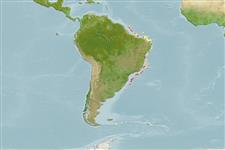Myxini (mixinas) (hagfishes) >
Myxiniformes (Hagfishes) >
Myxinidae (Hagfishes) > Myxininae
Etymology: Myxine: Greek, myxinos, word used by Linne, slime fish (1846) (Ref. 45335); sotoi: Named for Jules Marcelo Rosa Soto.
Ambiente / Clima / Intervalo
Ecologia
; marinhas batidemersal; não migratória; intervalo de profundidade 690 - 810 m (Ref. 40869). Deep-water, preferred ?
Southwest Atlantic: Brazil.
Tamanho / Peso / Idade
Maturity: Lm ? range ? - ? cm
Max length : 52.0 cm TL macho/indeterminado; (Ref. 40869)
Descrição suscinta
Morfologia | Morfometria
Color of live specimens pinkish red with whitish head anterior to first slime pore; whitish middorsal stripe extending from caudal finfold to about over gill apertures. Six pairs of gill pouches; a 2-cusp multicusp on both anterior and posterior sets of cusps, total cusps 38-44. Pores: prebranchial 28-38; trunk 61-73; tail 11-13; total 101-119. Ventral finfold 4-6 mm high.
Of 30 specimens, 26 were females, 3 males, 1 hermaphrodite. Four females had large eggs about 20 x 6 mm, but none of the eggs with encapsulated anchor filaments. The species lives on the continental slope.
Life cycle and mating behavior
Maturidade | Reprodução | Desova | Ovos | Fecundidade | Larvas
Copulatory organ absent. The gonads of hagfishes are situated in the peritoneal cavity. The ovary is found in the anterior portion of the gonad, and the testis is found in the posterior part. The animal becomes female if the cranial part of the gonad develops or male if the caudal part undergoes differentiation. If none develops, then the animal becomes sterile. If both anterior and posterior parts develop, then the animal becomes a functional hermaphrodite. However, hermaphroditism being characterised as functional needs to be validated by more reproduction studies (Ref. 51361 ).
Mincarone, M.M., 2001. Myxine sotoi, a new species of hagfish (Agnatha, Myxinidae) from Brazil. Bull. Mar. Sci. 68(3):479-483. (Ref. 40869)
Status na Lista Vermelha da IUCN (Ref. 115185)
CITES (Ref. 94142)
Not Evaluated
Perigo para os humanos
Harmless
Uso pelos humanos
Mais informação
Idade/TamanhoCrescimentoComprimento-pesoComprimento-comprimentoFrequências de comprimentoMorfometriaMorfologiaLarvasDinâmica larvalRecrutamentoAbundância
ReferênciasAquaculturaPerfil para aquaculturaEstirpesGenéticaFrequência alélicaHereditariedadeDoençasProcessamentoMass conversion
ColaboradoresFotosStamps, CoinsSonsCiguateraVelocidadeTipo de nataçãoÁrea branquialOtólitosCérebrosVisão
Ferramentas
Relatórios especiais
Baixar XML
Fontes da internet
